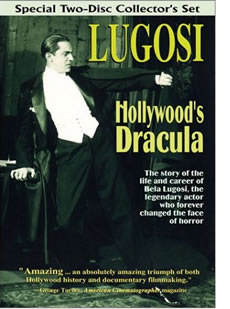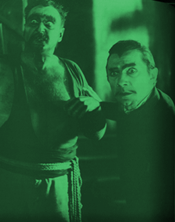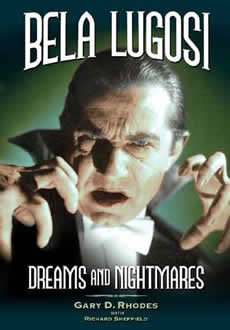 Zombos Says: Very Good
Zombos Says: Very Good
In spite of a disheartened director, and a greatly reduced budget, the 1931 film, Dracula, remains a classic for various reasons. For one thing, it was the first speaking horror film, although music was not used except for the opening credits. For another, it had indelible performances by skillful actors.
One performance stands out above the rest, and has left its mark on subsequent impersonations of the aristocrat of the undead, and ushered in an era of monsters that continues to this day.
Perhaps it was the oddly-inflected voice, with the thick accent, that hinted of wolves baying in the moonlight and fear-inducing evils-by-night, living in dark forests; or maybe it was the slow, determined mannerisms of a person, undead for centuries, for whom the urgencies of mortal time held little meaning; or it could have been those eyes that pierced right through you from under that furrowed brow. For whatever reasons, Bela Lugosi's performance of Dracula is the image of the vampire count that has stood the test of time.
In Lugosi: Hollywood's Dracula, writer and director Gary Rhodes explores Lugosi's amazing career using rare film clips and onscreen interviews with Lugosi's son, and others that knew Lugosi. What makes this documentary stand above the rest is its use of living history — people — to talk about the man and actor, providing us with an insightful glimpse into this iconic actor's professional and personal life. Combined with previously unseen footage and stills of Lugosi's early silent work, this two-disc DVD set clearly shows the broad range of talent and indomitableness of Lugosi as Hollywood ignored him, and squandered his acting in films well beneath his abilities.
Clever additions to the set are some of Lugosi's Old Time Radio 'appearances,' including the creepy, The Thirsty Death from Mystery House, 1944, and an Easter Egg! The funny mockumentary of Gary Rhodes' quest to sit in Bela Lugosi's chair can be viewed by going to the last page in the DVD Notes section until "Back" is highlighted, then pressing the Up arrow on your remote (or keyboard, if watching on a PC), followed by pressing "Enter."
 In the Deleted Scenes section, you will find more film footage and discussion on White Zombie (one of his creepiest performances) and Lugosi's Poverty Row films of the 1930s. From Murder Legendre in White Zombie, to Ygor in Son of Frankenstein, Lugosi's performances were always masterful and uniquely different, and created memorable characters in horror cinema.
In the Deleted Scenes section, you will find more film footage and discussion on White Zombie (one of his creepiest performances) and Lugosi's Poverty Row films of the 1930s. From Murder Legendre in White Zombie, to Ygor in Son of Frankenstein, Lugosi's performances were always masterful and uniquely different, and created memorable characters in horror cinema.
Director Gary Rhodes steps into the closet for an interview.
How did the idea for putting together the documentary come about?
I found the previous Lugosi documentaries [of which there were two of note (Lugosi: Forgotten King, and the A&E Bio)] to be very limited. Knowing that there were quite a few important and interesting people that neither of those films interviewed, such as Hope Lugosi, spurred me to plan the documentary. That was in tandem with the fact that I knew the whereabouts of a good deal of previously unseen footage.
What challenges did you face to bring the documentary to life?
There were a few challenges. That so many people we wanted to interview were already deceased. That some clips were so expensive we couldn't afford them. Those would be the two biggest challenges.
While watching the documentary, I was happy to see many clips and stills from Lugosi's silents' performances, something you rarely see. What challenges did you face in finding them, and why can't we see more of Lugosi's work in silent films?
The difficulty with Lugosi's silent work is that very little exists. We incorporated clips from the only surviving fragments of Lugosi's Hungarian career, which were thus seen publicly for the very first time. We found and used clips from Dance on the Volcano, which was the first time the clips had ever been seen (and we were thus responsible for its subsequent release through Sinister Cinema). And we used clips from Deerslayer, Silent Command, and Midnight Girl.
The reason more of his silent work can't be seen is that very few beyond those we drew clips from exist. Daughters Who Pay, from 1926, exists at the Eastman House in a version that must be transferred to safety stock and restored (at a cost of many thousands of dollars) before it can be viewed/released. But most of his work of the time simply doesn't exist, particularly his Hungarian and German period.
That montage of scenes you orchestrated, without narration, especially caught my attention. At first it didn't quite register, but when I watched the documentary a second time, I realized it captured much of Lugosi's acting versatility.
I appreciate your comment about the montage of scenes, as that was what I was driving after. Some way to encapsulate the larger whole of his work, especially given the time constraints of an hour film (which was still in fact longer than previous docs on BL, which were both hovering around 44mins). Plus, it was a way of working with the previously mentioned challenge of not having enough access to the Universal film clips due to cost.
As a writer and director, do you use a different approach when working on a documentary compared to the way you approach a regular movie?
I've been making films professionally since 1991, and my first documentary (Solo Flight: The Genius of Charlie Christian) is still in print from VIEW Video ... it raised enough funds to mark the hitherto unmarked grave of the seminal electric guitar player.
But I think in recent years my approach has changed, and that change has happened since/just after finishing the Lugosi doc. From Solo Flight thru Fiddlin Man and Lugosi: HD, I approached things too much as a historian, possibly. Privileging rare clips/interviews with those who hadn't been/etc., above the concerns of fictional film, which would be things like narrative form, three-act structures, and so forth.
I think doing the mockumentary film Chair (about Lugosi's Chair, which is a hidden feature/easter egg on the DVD made me begin thinking more about emphasizing the story being told over the tools used to tell it (like, say, rare clips or the like).
This has impacted more recent work of mine, particularly Banned in Oklahoma , Seawood (a just-finished film about alzheimer's ... a case study), and my movement more and more into fictional film (like Wit's End, a feature comedy). So it has been a transition.
 As for Bela, that was probably simultaneously the best and worst topic for me to do... the best because of my love for his work, my lifelong interest in him, and my knowledge of the subject (I had previously written Lugosi: His Life in Films, on Stage, and in the Hearts of Horror Lovers, a 1997 book for McFarland, recently back in print in paperback). But I say it was also the worst choice because I was/am too caught up in minor details, adoring, say, an extremely rare clip when most viewers wouldn't necessarily know whether it was rare or not.
As for Bela, that was probably simultaneously the best and worst topic for me to do... the best because of my love for his work, my lifelong interest in him, and my knowledge of the subject (I had previously written Lugosi: His Life in Films, on Stage, and in the Hearts of Horror Lovers, a 1997 book for McFarland, recently back in print in paperback). But I say it was also the worst choice because I was/am too caught up in minor details, adoring, say, an extremely rare clip when most viewers wouldn't necessarily know whether it was rare or not.
At any rate, my love for Lugosi continues. I have a book (that Dick Sheffield helped on) called Bela Lugosi, Dreams and Nightmares that is brand new... it is literally due out in print on Feb 20 of this year, in just a few weeks.



Comments